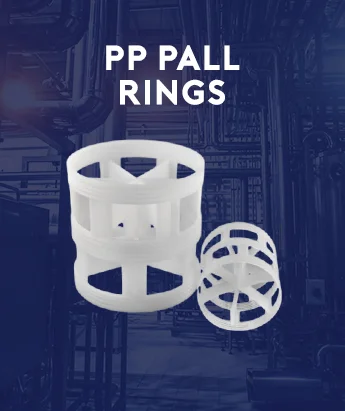Polypropylene (PP) Pall Rings are vital components in various industrial processes, particularly in chemical and petrochemical applications. These small, cylindrical plastic rings play a crucial role in enhancing mass transfer and facilitating efficient separation processes. If you’re considering using PP Pall Rings or are involved in their production, it’s essential to understand several key factors to ensure optimal performance and quality. In this article, we’ll delve into four important things to remember when making PP Pall Rings.
1. Material Selection: Opt for High-Quality Polypropylene
The quality of the polypropylene used in manufacturing PP Pall Rings significantly impacts their performance and durability. PP is renowned for its chemical resistance, high melting point, and excellent mechanical properties, making it an ideal material choice for applications involving corrosive environments and high temperatures.
When selecting PP for Pall Ring production, it’s crucial to source high-quality resin from reputable suppliers. The resin should meet stringent quality standards and be free from impurities that could compromise the integrity of the final product. Additionally, ensure that the PP resin exhibits the necessary mechanical strength and thermal stability required for the intended application. For instance, collaborating with a reliable PP pall ring supplier in India can ensure access to top-notch resin that meets these stringent criteria, guaranteeing the production of high-performance Pall Rings for various industrial applications.
2. Precision Manufacturing: Maintain Consistent Dimensions
Consistency in dimensions is paramount when producing PP Pall Rings to ensure uniformity in performance and packing efficiency. The manufacturing process involves extruding or injection molding the polypropylene resin into cylindrical shapes with specific dimensions and internal structural features.
To achieve precise dimensions, modern manufacturing facilities utilize advanced molding techniques and automated machinery equipped with precise controls. It’s essential to monitor and maintain optimal processing parameters such as temperature, pressure, and cooling rates to prevent variations in ring size and geometry.
Furthermore, stringent quality control measures, including dimensional inspections and testing, should be implemented throughout the production process to identify any deviations from specifications and ensure compliance with industry standards.
3. Surface Modification: Enhance Wetting Properties
Surface modification plays a crucial role in optimizing the performance of PP Pall Rings by improving their wetting properties and promoting efficient liquid distribution. While polypropylene inherently exhibits hydrophobic characteristics, surface treatments can enhance its wetting behavior, particularly in applications involving aqueous solutions or polar solvents.
Common surface modification techniques include chemical etching, plasma treatment, and coating deposition. These methods alter the surface chemistry of the PP Pall Rings, rendering them more hydrophilic and promoting better liquid spreading and contact with the internal surface area.
When implementing surface modification processes, it’s essential to strike a balance between enhancing wetting properties and maintaining the chemical resistance and mechanical integrity of the PP material. Thorough testing and evaluation should be conducted to assess the effectiveness and durability of the surface treatments under relevant operating conditions.
4. Quality Assurance: Conduct Rigorous Testing and Certification
Quality assurance is paramount in the production of PP Pall Rings to ensure reliability, consistency, and compliance with industry standards. Comprehensive testing and certification procedures should be implemented to validate the performance and quality of the manufactured rings before they are supplied to customers.
Key quality control measures include dimensional inspections, mechanical testing (such as compression strength and thermal stability), chemical resistance testing, and surface characterization. Additionally, PP Pall Rings intended for use in critical applications or industries may require certification from regulatory bodies or third-party organizations to validate their performance and safety.
By prioritizing quality assurance throughout the manufacturing process, suppliers can instill confidence in their customers regarding the reliability and performance of PP Pall Rings for various industrial applications.
Conclusion
PP Pall Rings play a vital role in enhancing mass transfer and separation processes in chemical and petrochemical industries. By adhering to key principles such as material selection, precision manufacturing, surface modification, and quality assurance, manufacturers can ensure the production of high-quality rings that meet the stringent demands of modern industrial applications. Whether you’re a supplier or user of PP Pall Rings, understanding these important considerations is essential for achieving optimal performance and efficiency in your processes.


